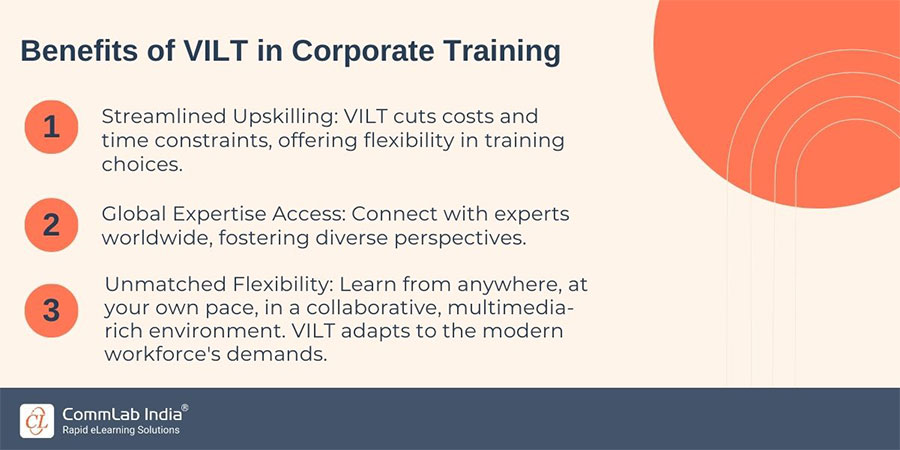8 Tips to Designing Impactful Virtual Instructor-Led Training
Want to make your VILT design more effective? Here are 8 pro tips that will help you in the journey...

In the current day’s fast-evolving landscape of digital learning, virtual instructor-led training (VILT) has gained a lot of importance. VILT is a synchronous learning approach that involves training delivered via an online classroom, with an instructor interacting with the learners.
Why is VILT Design a Hit?
Virtual Instructor-Led Training (VILT) seamlessly combines eLearning with the best elements of traditional classroom training, boosting the impact of your training initiatives. Learners find it highly engaging, leading to maximum comprehension and positive learning outcomes.
Simply put, VILT redefines employee development! It offers the following benefits:

Here's a video to help you know more about VILT:
In this blog, we will explore eight advanced strategies to create impactful virtual training experiences that captivate and educate.
8 Tips to Designing Impactful Virtual Instructor-Led Training
#1. Analyze Learner Behavior
Understanding your audience is the first step to creating impactful VILT. Analyzing learner behavior and preferences is crucial for tailoring your training to their needs. To do this effectively, consider the following:
- Gather Data: Use analytics tools to track learner progress and engagement. Monitor which content receives the most attention and which areas may need improvement.
- Feedback Loops: Encourage feedback from learners. Ask for their input on what works and what doesn't.
- Personalization: Use the data to customize the training experience. Offer content suggestions based on individual preferences and performance.
For example, a technology company implemented an AI-powered analytics platform to assess learner behavior. By tracking how employees interacted with the training materials, they identified areas where additional support and resources were needed. This data-driven approach led to a more personalized and effective VILT program.
#2. Gamify the Learning Experience
Gamification is a powerful strategy to make VILT engaging and enjoyable. Go beyond traditional leaderboards and badges and consider incorporating creative gamification ideas, such as:
- Scenarios and Role-Playing: Create real-life scenarios where learners can apply their knowledge.
- Interactive Challenges: Develop challenges and puzzles that require problem-solving and critical thinking.
- Rewards and Recognition: Offer virtual rewards, certificates, or even small prizes to top performers.
#3. Implement Adaptive Learning
Adaptive learning is a game-changer in VILT. It personalizes the learning experience by tailoring content to individual learners' needs and abilities. Here's how to implement it effectively:

#4. Harness the Potential of AI and Machine Learning
AI and machine learning are revolutionizing VILT. They can automate various tasks and provide insights into learner behavior and performance. Here are ways to leverage these technologies:
- Automated Content Generation: Use AI to generate personalized content based on learner preferences.
- Predictive Analytics: Predict learner success and offer timely interventions for those at risk of falling behind.
- Chatbots and Virtual Assistants: Deploy AI-powered chatbots to answer common learner queries in real-time.
Consider the example of an organization implementing AI-driven analytics to analyze training data. The data extracted helps program managers identify patterns that lead to successful outcomes. This information can be used to refine the training content and delivery methods, which further results in improved learning outcomes and reduced dropout rates.
→ Download Now: VILT – Comprehensive Beginners Guide [eBook]
#5. Create Immersive Simulations
Immersive simulations are essential for VILT, as they provide a dynamic and hands-on learning experience. Here's how to create impactful simulations:
- Realistic Scenarios: Develop scenarios that mimic real-life work situations, enabling learners to apply knowledge in a practical context.
- Interactivity: Encourage active participation and decision-making within the simulation.
- Feedback: Provide immediate feedback on learners' actions and choices to reinforce learning.
#6. Enable Cross-Platform Learning
In today's diverse world, learners access content on various devices. Ensuring cross-platform compatibility is essential for a seamless VILT experience. Here's how to achieve it:
- Responsive Design: Create content that adapts to different screen sizes and devices.
- Mobile Apps: Develop dedicated mobile apps for VILT platforms to enhance usability.
- Offline Access: Provide options for downloading content and participating in sessions without an internet connection.
Consider the case of a global corporation embracing cross-platform learning for their VILT program. For this, the company can include a responsive platform to allow employees to access training materials on their preferred devices, ensuring that learners across the world have a consistent and inclusive experience.
#7. Promote Self-Directed Learning
Empowering learners to take control of their learning journey is a key aspect of VILT. Consider the following strategies:
- Goal Setting: Encourage learners to set their own learning objectives and milestones.
- Resource Libraries: Provide access to a wealth of learning resources, allowing learners to explore topics of interest.
- Collaboration: Foster peer-to-peer learning and group projects for self-directed learning.
For instance, consider a tech startup encouraging self-directed learning by giving employees access to a curated library of online courses. The flexibility and control over the learning experience make the employees more motivated, productive, and adaptable to new technologies and processes.
#8. Encourage Peer-Led Training
Peer-led training promotes knowledge sharing and collaboration among learners. Here's how to implement it:
- Peer Mentoring: Assign experienced learners as mentors to guide and support newcomers.
- Group Projects: Encourage learners to work together on assignments and projects.
- Collaborative Learning Spaces: Create virtual spaces for learners to discuss and share insights.
A large manufacturing company introduced peer-led training sessions within their VILT program. Experienced employees took on mentorship roles, helping new hires acclimate to the company's culture and processes. This approach not only improved knowledge transfer but also strengthened the sense of community and collaboration among employees.
Wrapping Up
To wrap it to, designing impactful VILT requires a thoughtful and multifaceted approach. By analyzing learner behavior, gamifying the learning experience, implementing adaptive learning, harnessing AI and machine learning, creating immersive simulations, enabling cross-platform learning, promoting self-directed learning, and encouraging peer-led training, you can create VILT sessions that truly engage your employees. These strategies are essential for keeping up with the evolving landscape of education and training, making VILT a powerful tool for learners and organizations alike.
Want to get started with VILT? Here’s a beginners guide to help you:





